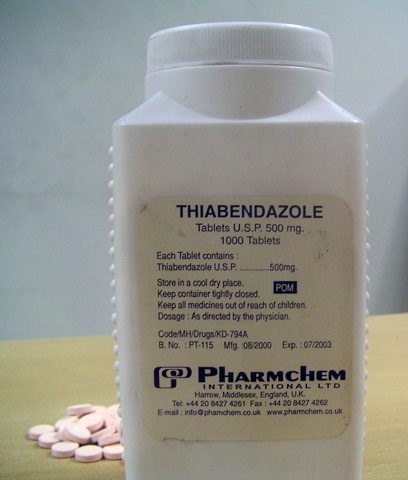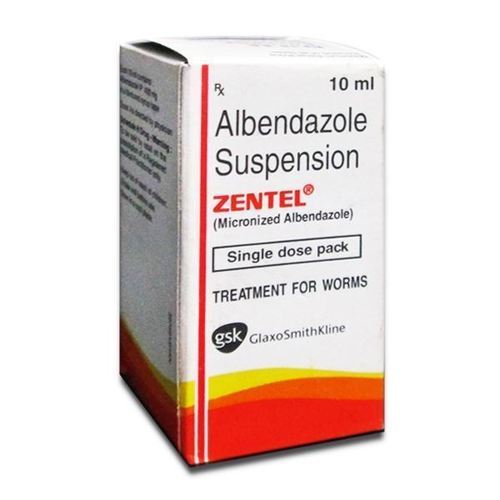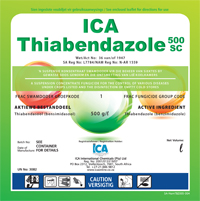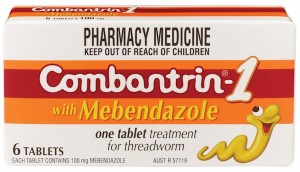Thiabendazole is an anthelmintic agent that is structurally related to albendazole and mebendazole.
Thiabendazole uses
Thiabendazole is used for the treatment of a variety of nematode (roundworm) infections, including strongyloidiasis (threadworm infection), cutaneous larva migrans (creeping eruption), and toxocariasis (visceral larva migrans). Thiabendazole also is used during the invasive stage of trichinosis to alleviate symptoms (e.g., fever, tenderness, muscle pain); however, the effect of the drug on larvae which have migrated to the muscles has not been fully evaluated and not all patients respond to the recommended dosage. Although thiabendazole is not indicated as primary therapy for enterobiasis (pinworm infection), additional therapy is not required in most patients with coexisting enterobiasis who receive the drug for any of the previously listed infections.
Thiabendazole may also be used for the treatment of hookworm infections caused by Ancylostoma duodenale or Necator americanus, ascariasis (roundworm infection), and trichuriasis (whipworm infection), but only when more specific therapy is not available or cannot be used or when further therapy with a second anthelmintic agent is desired. The drug’s broad spectrum of activity makes it useful in the treatment of some mixed helminthic infections. However, thiabendazole should not be used for the treatment of mixed infections with ascaris since it may cause these worms to migrate. In addition, the drug should be used only for the treatment of infections caused by susceptible helminths and should not be used prophylactically.

Nematode (Roundworm) Infections
Hookworm Infections
Thiabendazole is used for the treatment of cutaneous larva migrans (creeping eruption) caused by dog and cat hookworms. Although the disease usually is self-limited with spontaneous cure after several weeks or months, albendazole, ivermectin, or thiabendazole are considered the drugs of choice when treatment is indicated. In patients with cutaneous larva migrans, treatment with oral thiabendazole relieves symptoms and halts progression of the disease in the majority of patients within 2 days. Thiabendazole also has been applied topically to the skin as an extemporaneously prepared 2% solution of the drug in dimethyl sulfoxide (DMSO), a 10-15% suspension (e.g., using the commercially available 10% oral suspension), or an extemporaneously prepared 10% ointment (e.g., in white petrolatum), for the treatment of cutaneous larva migrans. Such topical therapy generally halts progression of the disease within 1-3 weeks and may be preferred for some patients, particularly those with early disease, because of the reduced risk of adverse effects compared with oral therapy. Thiabendazole can be used for the treatment of intestinal hookworm infections caused by Ancylostoma duodenale or Necator americanus when more specific therapy is not available or cannot be used or when further therapy with a second agent is desirable. However, albendazole, mebendazole, or pyrantel pamoate are considered the drugs of choice for the treatment of intestinal hookworm infections.
Strongyloidiasis
Thiabendazole is used for the treatment of strongyloidiasis caused by Strongyloides stercoralis (threadworm). Some clinicians consider ivermectin the drug of choice and thiabendazole an alternative for the treatment of strongyloidiasis.
Toxocariasis (Visceral Larva Migrans)
Thiabendazole is used for the treatment of toxocariasis (visceral larva migrans) caused by Toxocara canis or T. cati (dog and cat roundworms). Some clinicians consider albendazole or mebendazole the drugs of choice for treatment of this infection. In severe cases with cardiac, ocular, or CNS involvement, corticosteroids also may be indicated. Treatment may not be effective in ocular larva migrans; inflammation may be reduced by corticosteroid injections and surgery may be necessary for secondary damage.

Trichinosis
Thiabendazole has been used during the invasive stage of trichinosis to alleviate symptoms (e.g., fever) and eosinophilia; however, the effect of the drug on larvae that have migrated to the muscles has not been fully evaluated and not all patients respond to the recommended dosage. Albendazole or mebendazole usually are considered the drugs of choice for the treatment of trichinosis.
Other Nematode Infections
Thiabendazole can be used for the treatment of ascariasis caused by Ascaris lumbricoides when more specific therapy is not available or cannot be used or when further therapy with a second agent is desirable. However, albendazole, mebendazole, or pyrantel pamoate are considered the drugs of choice for the treatment of ascariasis.
Although thiabendazole is not considered primary therapy for enterobiasis caused by Enterobius vermicularis (pinworm), additional anthelmintic therapy usually is not required in patients with coexisting enterobiasis receiving thiabendazole for another infection. Albendazole, mebendazole, or pyrantel pamoate are considered the drugs of choice for the treatment of enterobiasis.
Although thiabendazole can be used for the treatment of trichuriasis caused by Trichuris trichiura (whipworm) when more specific therapy is not available or cannot be used or when further therapy with a second agent is desirable, mebendazole usually is considered the drug of choice and albendazole the alternative for the treatment of trichuriasis. Thiabendazole has been used for the treatment of infections caused by Trichostrongylus, but pyrantel pamoate usually is considered the drug of choice and albendazole and mebendazole are considered alternatives for the treatment of Trichostrongylus infections.
Dosage and Administration
Administration
Thiabendazole is administered orally, preferably after meals. Tablets should be chewed before swallowing. Special diet, fasting, or purgation prior to administration of the drug is not necessary. Patients should be advised of hygienic precautions needed to minimize reinfection. The drug also has been administered topically for the treatment of cutaneous larva migrans.
Dosage
The usual dose of thiabendazole is 25 mg/kg (10 mg/pound) for patients weighing less than 70 kg and 1.5 g for patients weighing over 70 kg; some clinicians recommend that children be given 22 mg/kg or 650 mg/m2. The maximum daily dose is 3 g. The approximate dose based on patient weight is as follows: Patient Weight Dose 13.-22. kg 250 mg 22.-34.0 kg 500 mg 34.-45. kg 750 mg 45.-56. kg 1 g 56.-68. kg 1.25 g = 68. kg 1.5 g
Nematode (Roundworm) Infections
Cutaneous Larva Migrans
For the treatment of cutaneous larva migrans (creeping eruption) caused by dog and cat hookworms, the usual oral dose of thiabendazole may be given twice daily for 2 consecutive days. If active lesions are still present 2 days after completion of a 2-day course of therapy, a second course of treatment should be administered. Cutaneous larva migrans has also been treated topically with a thiabendazole 10-15% suspension or a 10% ointment (e.g., in white petrolatum) applied sparingly to all lesions several (e.g., 4-6) times daily or with a 2% solution in dimethyl sulfoxide (DMSO) applied twice daily, until lesions were inactivated; occlusive dressings were used concomitantly in some patients. Occasionally, topical therapy was continued for 1 or 2 days to 2 weeks after inactivation of the last lesions.
Strongyloidiasis
For the treatment of strongyloidiasis caused by Strongyloides stercoralis (threadworm), the usual dose of thiabendazole may be given twice daily for 2 consecutive days.
Some clinicians recommend that adults and pediatric patients receive thiabendazole in a dosage of 25 mg/kg twice daily (maximum 3 g daily) for 2 consecutive days; however, this dosage is likely to be toxic and may need to be reduced. Alternatively, a single dose of 50 mg/kg (20 mg/pound) may be used (e.g., in mass-treatment programs), but a higher incidence of adverse effects usually occurs with this dose. Disseminated or hyperinfection syndrome of strongyloidiasis, which occurs principally in immunocompromised individuals, may require longer than 2 days of thiabendazole therapy (e.g., at least 5-7 days) and/or possibly higher than usual doses. It may be necessary to repeat therapy or use other agents in immunocompromised individuals or those with disseminated disease.
Toxocariasis
For the treatment of toxocariasis (visceral larva migrans) caused by Toxocara canis or T. cati (dog and cat roundworms), the manufacturer states that the usual dose of thiabendazole may be given twice daily for 7 consecutive days. Safety and efficacy data for the 7-day treatment regimen are limited. Trichinosis The optimal dosage of thiabendazole for the treatment of trichinosis caused by Trichinella spiralis has not been established; however, for the symptomatic treatment of trichinosis, the manufacturer states that 2 doses of thiabendazole may be given daily for 2-4 consecutive days according to the response of the patient.
Other Nematode Infections
Although other drugs are preferred for the treatment of these infections,the manufacturer states that for the treatment of ascariasis (roundworm infection), hookworm infections caused by Ancylostoma duodenale or Necator americanus, or trichuriasis (whipworm infection), the usual dose of thiabendazole may be given twice daily for 2 consecutive days. Alternatively, a single dose of 50 mg/kg (20 mg/pound) may be used, but a higher incidence of adverse effects usually occurs with this dose. For the treatment of trichostrongylosis, the usual dose of thiabendazole has been given twice daily for 2 consecutive days.

Cautions
Adverse Effects
Adverse effects of thiabendazole are usually mild and transient, generally occurring 3-4 hours after administration of the drug and lasting 2-8 hours. Up to one-third of patients treated with the recommended dosage of thiabendazole have experienced one or more adverse effects for several hours. The incidence of adverse effects increases with increasing dosage and length of treatment. The most frequent adverse effects of thiabendazole are anorexia, nausea, vomiting, and dizziness.
Diarrhea, epigastric distress, weariness, drowsiness, and headache occur less frequently. Giddiness, seizures, vertigo, paresthesia, and psychic disturbances may also occur. Rarely, tinnitus, hyperirritability, numbness, abnormal sensation in eyes, blurred vision, xanthopsia, drying of mucous membranes (e.g., mouth, eyes), altered sense of smell, hypotension, bradycardia, collapse, shock, transient increases in cephalin flocculation and serum concentrations of AST (SGOT), jaundice, cholestasis and parenchymal liver damage, nephrotoxicity, hyperglycemia, transient leukopenia, enuresis, malodor of the urine, crystalluria, and hematuria have occurred. Appearance of live Ascaris in the mouth and nose has occurred in some patients with ascariasis during therapy with thiabendazole.
Hypersensitivity reactions consisting of pruritus, fever, facial flush, chills, conjunctival injection, rashes (including perianal), angioedema, anaphylaxis, erythema multiforme (including Stevens-Johnson syndrome, which may be fatal), and lymphadenopathy have been reported in some patients receiving thiabendazole.
Precautions and Contraindications
Because adverse CNS effects of thiabendazole may occur quite frequently, patients should be warned that the drug may impair their ability to perform activities requiring mental alertness or physical coordination (e.g., operating machinery, driving a motor vehicle) and that such activities should be avoided. Thiabendazole should be used with caution and careful monitoring in patients with hepatic or renal dysfunction and in those in whom vomiting might be dangerous. Thiabendazole should also be used with caution in treating patients with severe malnutrition or anemia. Ideally, supportive therapy is indicated for anemic, dehydrated, or malnourished patients prior to administration of the drug. If hypersensitivity reactions occur in patients receiving thiabendazole, the drug should be discontinued immediately and should not be resumed. Thiabendazole is contraindicated in patients who are hypersensitive to the drug.
Pediatric Precautions
Because of limited experience with thiabendazole for the treatment of strongyloidiasis, ascariasis, hookworm infections, trichuriasis, and trichinosis in children weighing less than 13. kg, the drug should be used in such children only when the potential benefits justify the possible risks.
Mutagenicity and Carcinogenicity
No evidence of thiabendazole-induced mutagenic activity was seen with an in vitro microbial mutagen test, the micronucleus test, or an in vivo host-mediated assay. No evidence of carcinogenic potential has been seen in numerous short- and long-term studies in animals receiving thiabendazole at doses up to 15 times the usual human dose.
Pregnancy, Fertitlity and Lactation
Reproduction and teratogenicity studies in rats receiving thiabendazole doses equivalent to the human dose, in mice receiving doses 2.5 times the usual human dose, or rabbits receiving doses up to 15 times the usual human dose have not revealed evidence of harm to the fetus. In addition, in other studies in mice receiving thiabendazole orally in an aqueous solution at a dose 10 times the usual human dose, no evidence of harm to the fetus was observed; however, cleft palate and axial skeletal defects were observed when the drug was suspended in olive oil and given at the same dose. There are no adequate and controlled studies to date using thiabendazole in pregnant women, and the drug should be used during pregnancy only when the potential benefits justify the possible risks to the fetus. Reproduction studies in mice receiving thiabendazole doses 2.5 times the usual human dose or in rats receiving doses equivalent to the usual human dose have not revealed evidence of impaired fertility. It is not known whether thiabendazole is distributed into milk. Because of the potential for serious adverse reactions to thiabendazole in nursing infants, a decision should be made whether to discontinue nursing or the drug, taking into account the importance of the drug to the woman.
Drug Interactions
Thiabendazole may compete with other drugs (e.g., theophylline) for sites of metabolism in the liver and thereby increase serum concentrations of such drugs to potentially toxic levels. When thiabendazole and a xanthine derivative are used concomitantly, it may be necessary to monitor serum concentrations of the xanthine derivative and/or reduce its dosage. Patients receiving the drugs concomitantly should be carefully monitored.
Acute Toxcicity
The oral LD50 of thiabendazole in mice, rats, and rabbits is 3.6, 3.1, and 3.8 g/kg, respectively. Overdosage of the drug may be associated with transient visual disturbances and psychic alterations. Treatment of thiabendazole overdosage involves symptomatic and supportive care; there is no specific antidote for thiabendazole intoxication.
The manufacturer recommends that emesis be induced or gastric lavage be performed carefully. Mechanism of Action Although the exact mechanism of anthelmintic activity of thiabendazole has not been fully elucidated, the drug has been shown to inhibit the helminth-specific enzyme, fumarate reductase. In animals, thiabendazole has anti-inflammatory, antipyretic, and analgesic effects.
Spectrum Thiabendazole is active against most intestinal nematodes (roundworms) pathogenic to humans, including:
- Ancylostoma braziliense (dog and cat hookworm)
- Ancylostoma caninum (dog hookworm)
- Ancylostoma duodenale (hookworm)
- Ascaris lumbricoides (roundworm)
- Capillaria philippinensis (Philippine threadworm)
- Dracunculus medinensis (guinea worm), Enterobius vermicularis (pinworm)
- Necator americanus (hookworm)
- Strongyloides stercoralis (threadworm)
- Trichostrongylus species (hairworm)
- Trichuris trichiura (whipworm);
however, the drug’s activity against T. trichiura is variable and usually is less than that against other nematodes. Thiabendazole has been reported to be larvicidal against Trichinella spiralis in pig muscle and appears to be active against the intestinal phase of this infection in humans; however, the drug’s activity against larvae that have migrated in humans has not been established. Thiabendazole also suppresses egg and/or larval production by some nematodes and may inhibit the subsequent development of eggs or larvae passed in feces. In animals and in vitro, thiabendazole also appears to be active against a variety of saprophytic and pathogenic fungi, particularly against Trichophyton and Microsporum species.
Pharmacokinetics
Absorption
Thiabendazole is rapidly absorbed from the GI tract; the drug can also be absorbed through the skin. Peak plasma concentrations occur within 1-2 hours following oral administration; most of the drug is eliminated from plasma within 8 hours following administration of a single oral dose.
Distribution
It is not known whether thiabendazole is distributed into milk.

Elimination
Thiabendazole is extensively metabolized in the liver via hydroxylation to 5-hydroxythiabendazole and is subsequently conjugated with sulfuric and/or glucuronic acid. Thiabendazole and its metabolites are excreted in urine and feces. Approximately 90% of an oral dose of thiabendazole is excreted in urine within 48 hours, principally as glucuronide or sulfate conjugates of 5-hydroxythiabendazole, and approximately 5% of an oral dose of the drug is excreted in feces; most of the dose is excreted within the first 24 hours.
Chemistry and Stability
Chemistry
Thiabendazole is a benzimidazole-derivative anthelmintic agent. The drug is structurally related to albendazole and mebendazole. Thiabendazole occurs as a white to practically white, odorless or practically odorless powder and is practically insoluble in water and slightly soluble in alcohol. The drug has a pKa of 4.7. Commercially available thiabendazole oral suspension has a pH of 3.4-4. and contains sorbic acid as a preservative.
Stability
Thiabendazole tablets and oral suspension should be stored in tight containers.
Preparations
Thiabendazole Oral Suspension 500 mg/5 mL Mintezol®, (with sorbic acid 0.1%) Merck Tablets, chewable 500 mg Mintezol®, (scored) Merck AHFS DRUG INFORMATION® (2004)


Can I buy thiabendazole ?